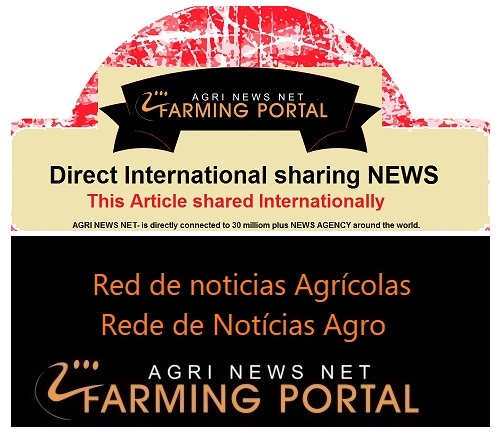World Farming Agriculture Commodity news - Weekly Updated - Exclusive and very popular - Delivering a Media service 365 days of the year.
In March, Brazilian soybean farmgate prices decreased by 1% compared to the previous month. Despite a record Brazilian crop, estimated at 170m metric tons, the global geopolitical tensions are amplifying soybean basis at ports.Farmgate corn prices in March were 8% higher than the previous month. Year-to-date prices were 56% above last year levels. A robust increase in local corn consumption and low stocks is supporting local corn prices.In February 2025, Brazilian soybean exports reached 6.4m metric tons, 221% higher than the previous month. The cumulated soybean exports are 21% below last year´s levels.Corn exports in February 2025 totaled 1.4m metric tons, 66% below the previous month.Safrinha crop conditions are overall favorable.
Brazil has gained access to the Sarawak market in Malaysia for halal-certified poultry exports, following successful negotiations led by the Ministry of Agriculture and Livestock. The Brazilian Animal Protein Association (ABPA) celebrated the announcement, which marks a new chapter in Brazil’s expanding presence in Southeast Asia. Sarawak, Malaysia’s largest state with a population of around 2.6 million, approved the import of Brazilian chicken meat after a series of technical and diplomatic missions. A Malaysian delegation visited Brazil in October 2023 to assess poultry and beef production systems. This led to a follow-up mission during which Malaysia’s Minister of Agriculture signed a health certificate authorising the trade. Three Brazilian poultry plants—located in Minas Gerais, Mato Grosso do Sul, and Paraná—received export approval. “Although Sarawak is a predominantly non-Muslim autonomous state, all shipments will follow halal standards, in line with Malaysian requirements,” said ABPA president Ricardo Santin. Santin added that Brazil hopes to expand its access further, with ongoing negotiations aimed at opening the Sarawak market to Brazilian pork. He noted that Brazil’s poultry exports would complement local production and help stabilise food prices in a region grappling with biosecurity issues and inflation.
The European Economic and Social Committee (EESC) has praised the European Commission’s New Vision on Agriculture and Food, presented in February and debated on March 27 with EU Agriculture Commissioner Christophe Hansen, for proposing measures to boost farmers’ bargaining power in food supply chains. The plan aims to enhance competitiveness, resilience, and fairness in the agri-food sector through transparency, written contracts with renegotiation clauses, and protections against below-cost selling, aligning with many EESC recommendations. It also promises stronger food policy dialogue, a holistic supply chain approach, risk management frameworks, and support for young farmers—echoing EESC calls for crisis tools, strategic reserves, and generational renewal. However, the EESC seeks more ambition in the Common Agricultural Policy (CAP), citing concerns over the uncertain post-2027 EU budget, weak social conditionalities, and insufficient action on market concentration and financial speculation’s impact on food prices. The EESC pledges ongoing support to turn the vision into practical policies benefiting farmers, the food industry, consumers, and rural communities.
Snow plays a key role in regulating temperature by reflecting sunlight (high albedo), preventing heat absorption by the ground, and requiring significant energy to melt—about 2,000 joules per kilogram to warm it one degree Celsius and 33,500 joules per kilogram to change it from ice to water. For example, warming 1 kg of snow from -10°C to 0°C takes 20,000 joules, with an additional 33,500 joules to melt it, explaining why snow-covered areas stay cooler than bare ones. Temperature inversions, where warm air sits atop a thin layer of cold air trapped at the surface, further complicate weather patterns, especially in spring due to snow’s cooling effect. These inversions, common in valleys like Manitoba’s Red River Valley, create stable, cold conditions at ground level (e.g., -10°C) while warmer air (up to 15°C) hovers above, leading to prolonged fog and low clouds. A recent storm in the Prairies highlighted this, with heavy snow in Alberta and northwestern Ontario, influenced by local topography like valleys and depressions, amplifying these effects.
Eco-conscious consumers couldn’t sustain the hype around plant-based meat startups like Beyond Meat, which struggled with price, taste, and resistance from traditional meat industries. In contrast, lab-grown chocolate is gaining traction as a solution to the $130 billion confectionery industry’s woes, driven by cocoa supply issues. Disease and weather in Ivory Coast and Ghana (60% of global supply) caused cocoa prices to quadruple in 2024, with production lagging demand for three years, though a 142,000-ton surplus is now forecast. This volatility has disrupted hedging for companies like Hershey, which faces shrinking margins (down nearly 10 points over three years) and limited ability to raise prices on its affordable treats. confectioners are turning to alternatives—palm oil, shea butter, and lab-grown cocoa via “precision fermentation” by startups like Voyage Foods and Planet A Foods, backed by giants like Lindt and Mondelez. Unlike plant-based meat, this shift has industry support and targets a $13.5 billion market, suggesting cocoa could face real disruption.
U.S. beef exports to China have plummeted, with sales dropping to just 54 metric tons in the week ending March 20, down from over 2,000 tons weekly in early 2025, after China let export registrations for hundreds of U.S. beef facilities lapse on March 16, according to U.S. government data. This follows a tit-for-tat tariff dispute that increased duties on U.S. meat, making it less competitive, amid already strained U.S.-China relations. Uncertainty over whether post-March 16 beef shipments will clear Chinese customs has stalled deals, despite renewed registrations for U.S. pork and poultry. The decline hurts U.S. meatpackers like Tyson Foods, already squeezed by high cattle costs and tight supplies, while China’s Commerce Ministry investigates surging beef imports that have depressed its domestic prices, with a hearing scheduled for next week.

.

DISCLAIMER
The views and opinions expressed in this program are those of the writers and do not necessarily reflect the views or positions of any entities they represent. The information contained in this website is for general information purposes only. The information is provided by CRA and while we endeavour to keep the information up to date and correct, we make no representations or warranties of any kind, express or implied, about the completeness, accuracy, reliability, suitability or availability with respect to the website or the information, products, services, or related graphics contained on the website for any purpose. Any reliance you place on such information is therefore strictly at your own risk.






















